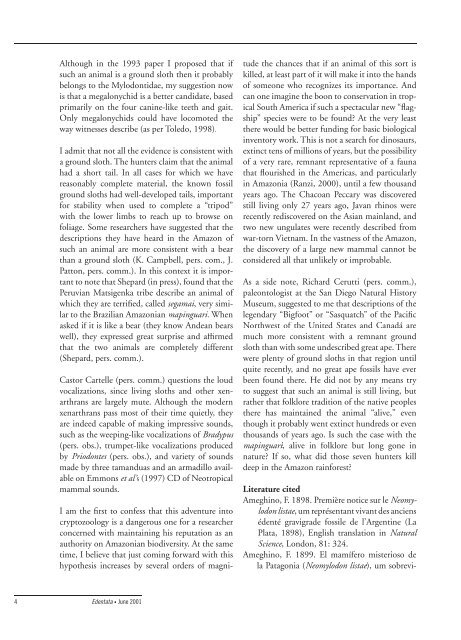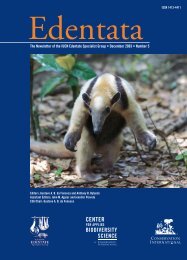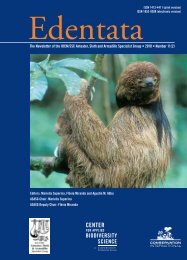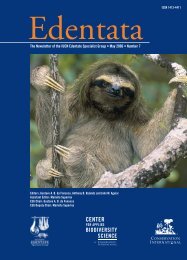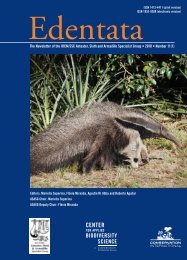Edentata 4 - Anteater, Sloth & Armadillo Specialist Group
Edentata 4 - Anteater, Sloth & Armadillo Specialist Group
Edentata 4 - Anteater, Sloth & Armadillo Specialist Group
Create successful ePaper yourself
Turn your PDF publications into a flip-book with our unique Google optimized e-Paper software.
Although in the 1993 paper I proposed that if<br />
such an animal is a ground sloth then it probably<br />
belongs to the Mylodontidae, my suggestion now<br />
is that a megalonychid is a better candidate, based<br />
primarily on the four canine-like teeth and gait.<br />
Only megalonychids could have locomoted the<br />
way witnesses describe (as per Toledo, 1998).<br />
I admit that not all the evidence is consistent with<br />
a ground sloth. The hunters claim that the animal<br />
had a short tail. In all cases for which we have<br />
reasonably complete material, the known fossil<br />
ground sloths had well-developed tails, important<br />
for stability when used to complete a “tripod”<br />
with the lower limbs to reach up to browse on<br />
foliage. Some researchers have suggested that the<br />
descriptions they have heard in the Amazon of<br />
such an animal are more consistent with a bear<br />
than a ground sloth (K. Campbell, pers. com., J.<br />
Patton, pers. comm.). In this context it is important<br />
to note that Shepard (in press), found that the<br />
Peruvian Matsigenka tribe describe an animal of<br />
which they are terrified, called segamai, very simi-<br />
lar to the Brazilian Amazonian mapinguari. When<br />
asked if it is like a bear (they know Andean bears<br />
well), they expressed great surprise and affirmed<br />
that the two animals are completely different<br />
(Shepard, pers. comm.).<br />
Castor Cartelle (pers. comm.) questions the loud<br />
vocalizations, since living sloths and other xenarthrans<br />
are largely mute. Although the modern<br />
xenarthrans pass most of their time quietly, they<br />
are indeed capable of making impressive sounds,<br />
such as the weeping-like vocalizations of Bradypus<br />
(pers. obs.), trumpet-like vocalizations produced<br />
by Priodontes (pers. obs.), and variety of sounds<br />
made by three tamanduas and an armadillo available<br />
on Emmons et al’s (1997) CD of Neotropical<br />
mammal sounds.<br />
I am the first to confess that this adventure into<br />
cryptozoology is a dangerous one for a researcher<br />
concerned with maintaining his reputation as an<br />
authority on Amazonian biodiversity. At the same<br />
time, I believe that just coming forward with this<br />
hypothesis increases by several orders of magnitude<br />
the chances that if an animal of this sort is<br />
killed, at least part of it will make it into the hands<br />
of someone who recognizes its importance. And<br />
can one imagine the boon to conservation in tropical<br />
South America if such a spectacular new “flagship”<br />
species were to be found? At the very least<br />
there would be better funding for basic biological<br />
inventory work. This is not a search for dinosaurs,<br />
extinct tens of millions of years, but the possibility<br />
of a very rare, remnant representative of a fauna<br />
that flourished in the Americas, and particularly<br />
in Amazonia (Ranzi, 2000), until a few thousand<br />
years ago. The Chacoan Peccary was discovered<br />
still living only 27 years ago, Javan rhinos were<br />
recently rediscovered on the Asian mainland, and<br />
two new ungulates were recently described from<br />
war-torn Vietnam. In the vastness of the Amazon,<br />
the discovery of a large new mammal cannot be<br />
considered all that unlikely or improbable.<br />
As a side note, Richard Cerutti (pers. comm.),<br />
paleontologist at the San Diego Natural History<br />
Museum, suggested to me that descriptions of the<br />
legendary “Bigfoot” or “Sasquatch” of the Pacific<br />
Northwest of the United States and Canadá are<br />
much more consistent with a remnant ground<br />
sloth than with some undescribed great ape. There<br />
were plenty of ground sloths in that region until<br />
quite recently, and no great ape fossils have ever<br />
been found there. He did not by any means try<br />
to suggest that such an animal is still living, but<br />
rather that folklore tradition of the native peoples<br />
there has maintained the animal “alive,” even<br />
though it probably went extinct hundreds or even<br />
thousands of years ago. Is such the case with the<br />
mapinguari, alive in folklore but long gone in<br />
nature? If so, what did those seven hunters kill<br />
deep in the Amazon rainforest?<br />
Literature cited<br />
Ameghino, F. 1898. Première notice sur le Neomy-<br />
lodon listae, um représentant vivant des anciens<br />
édenté gravigrade fossile de l’Argentine (La<br />
Plata, 1898), English translation in Natural<br />
Science, London, 81: 324.<br />
Ameghino, F. 1899. El mamífero misterioso de<br />
la Patagonia (Neomylodon listae), um sobrevi-<br />
4<br />
<strong>Edentata</strong> • June 2001


